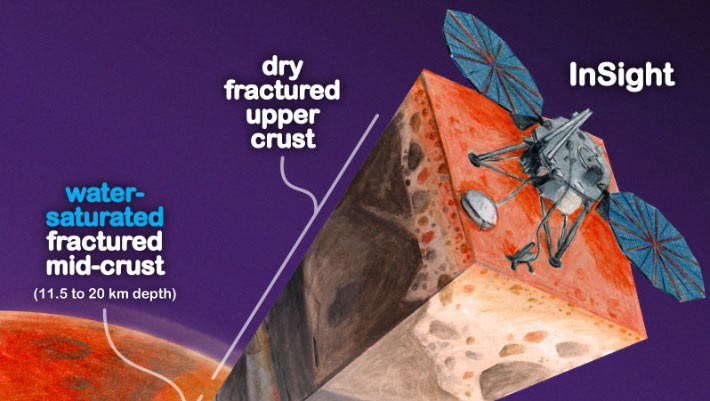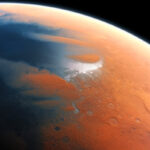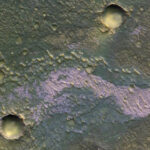New data about the Martian crust gathered by NASA’s InSight lander allowed geophysicists at the University of California San Diego and the University of California Berkeley to estimate that the amount of groundwater could cover the entire planet to a depth of between 1 and 2 km. It’s located in tiny cracks and pores in rock in the planet’s mid-crust, between 11.5 and 20 km below the surface.
Cutaway view of NASA’s InSight lander and data it collected. Image credit: James Tuttle Keane / Aaron Rodriquez.
“Liquid water existed at least episodically on Mars in rivers, lakes, oceans, and aquifers during the Noachian and Hesperian, more than 3 billion years ago,” said Dr. Vashan Wright from the Scripps Institution of Oceanography at the University of California San Diego and colleagues.
“Mars lost its ability to host persistent bodies of liquid water on its surface after the planet lost most of its atmosphere during this time period.”
“The ancient surface water may have been incorporated in minerals, buried as ice, sequestered as liquid in deep aquifers, or lost to space.”
For the study, Dr. Wright and his colleagues used data that InSight collected during a four-year mission ending in 2022.
The lander collected information from the ground directly beneath it on variables such as the speed of marsquake waves from which scientists can infer what substances reside beneath the surface.
The data were fed into a model informed by a mathematical theory of rock physics.
From it, the researchers determined that the presence of liquid water in the crust most plausibly explained the data.
“Establishing that there is a big reservoir of liquid water provides some window into what the climate was like or could be like,” said University of California Berkeley’s Professor Michael Manga.
“And water is necessary for life as we know it. I don’t see why the underground reservoir is not a habitable environment. It’s certainly true on Earth — deep, deep mines host life, the bottom of the ocean hosts life.”
“We haven’t found any evidence for life on Mars, but at least we have identified a place that should, in principle, be able to sustain life.”
“Lots of evidence — river channels, deltas and lake deposits, as well as water-altered rock – support the hypothesis that water once flowed on the planet’s surface.”
“But that wet period ended more than 3 billion years ago, after Mars lost its atmosphere.”
“Planetary scientists on Earth have sent many probes and landers to the planet to find out what happened to that water — the water frozen in Mars’ polar ice caps can’t account for it all — as well as when it happened, and whether life exists or used to exist on the planet,” the authors said.
“The new findings are an indication that much of the water did not escape into space but filtered down into the crust.”
“The new paper analyzed the deeper crust and concluded that the available data are best explained by a water-saturated mid-crust below Insight’s location.”
“Assuming the crust is similar throughout the planet, there should be more water in this mid-crust zone than the volumes proposed to have filled hypothesized ancient Martian oceans.”
The findings appear in the Proceedings of the National Academy of Sciences.
_____
Vashan Wright et al. 2024. Liquid water in the Martian mid-crust. PNAS 121 (35): e2409983121; doi: 10.1073/pnas.2409983121




